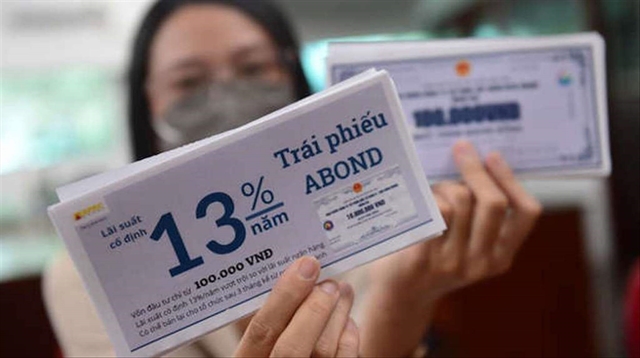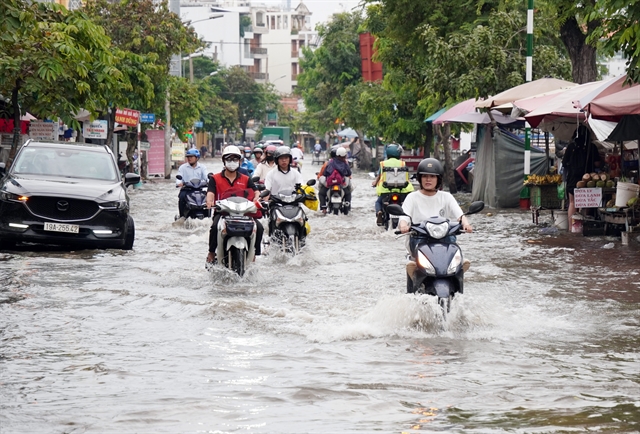 Society
Society

 |
| Trần Xuân Soạn Street in Tân Thuận Ward, HCM City is flooded by high tides in on November 6, 2025. — VNA/VNS Photo Trung Tuyến |
HÀ NỘI — The Ministry of Construction has reported to the Government on the nationwide urban flooding situation and proposed key solutions to comprehensively address the issue.
According to the ministry, Việt Nam has about 900 urban areas, with an urbanisation rate of 44.3 per cent. This figure is expected to exceed 50 per cent by 2030.
Rapid concretisation, loss of natural water surfaces and waterways, and increasingly extreme rainfall have contributed to worsening urban flooding.
The goal is that by 2035, Việt Nam will be able to control severe flooding and build a modern climate-adaptive drainage system.
Potential GDP loss
In 2024, about 397 flooded spots totalling 924ha were recorded nationwide.
In major cities such as Hà Nội, HCM City, Đà Nẵng, Huế, Cần Thơ and Hải Phòng, many central areas are often submerged under 0.3 to 0.8 metres of floodwaters. Drainage can last from three to six hours or longer during high tides.
This situation causes major socio-economic losses of about 1-1.5 per cent of urban GDP each year while also negatively affecting the environment, traffic, public health and the urban landscape.
Ageing drainage systems also lead to wastewater overflow during floods, increasing the risk of disease outbreaks in densely populated areas.
Insufficient drainage systems
Most urban drainage systems in Việt Nam were built before the 1990s as combined sewers for rainwater and wastewater. Many are now degraded, silted or undersized and fail to meet current demands.
Việt Nam has 83 urban wastewater treatment plants with a combined capacity of over two million cubic metres per day, but they usually operate at only 50-60 per cent due to incomplete collection networks.
Only around 18 per cent of domestic wastewater is properly collected and treated, mainly in major developed cities.
Meanwhile, investment in drainage remains limited, with approximately US$3 billion spent between 1995 and 2021, while an estimated VNĐ250-300 trillion ($10-12 billion) will be required by 2030.
The State budget can only cover 20-25 per cent of this amount, and public-private partnership projects remain scarce.
The ministry’s report also noted that drainage planning has not kept pace with urbanisation and lacks alignment with planning for traffic, land use and irrigation. Small-scale ground elevation, lake filling and canal encroachment have increased flooding in low-lying areas.
Updated climate change scenarios show that extreme rainfall in urban zones could rise by 20-30 per cent, with heavy-rain days doubling compared to the 1990-2000 period.
Sea levels rising by 3-4mm per year, combined with high tides, strong storms, river floods and land subsidence of 1.5-2.5cm annually, are putting southern cities such as HCM City, Cần Thơ and Cà Mau at higher flood risk.
Urban flooding now occurs nationwide in various forms, including rain-induced flooding and insufficient drainage in Hà Nội, Hải Phòng and Đà Lạt; tidal flooding in HCM City, Cần Thơ and Đà Nẵng; as well as flooding worsened by blocked flows or land subsidence in downstream and coastal areas.
National project
The Ministry of Construction has proposed that the Government issue a resolution to strengthen the management and investment of urban drainage systems for 2026-2035 and direct the development of a national project on climate-adaptive drainage and flood prevention by 2035 with a vision to 2050.
The project will focus on aligning drainage planning with transport, irrigation and land-use plans in each locality while prioritising key works such as retention lakes, pumping stations, tide-control gates, regional pipelines and wastewater treatment systems.
The ministry is currently revising the Law on Water Supply and Drainage, expected to be submitted to the National Assembly in May 2026, which will serve as a unified legal framework for drainage, wastewater treatment and urban flood management.
In addition to improving regulations on flood control, the ministry highlights the need to apply technologies, diversify funding sources and enhance public awareness to prevent littering, canal encroachment and protect natural drainage systems.
By 2035, Việt Nam aims to fundamentally control flooding in major cities, raise the rate of collected and treated domestic wastewater to 30-40 per cent and ensure that major cities have separate or semi-separate drainage systems.
The country also aims to complete national flood mapping along with smart warning and drainage operation systems. — VNS